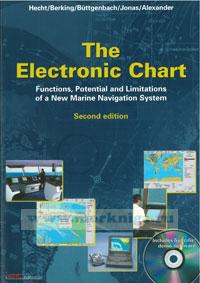The Electronic Chart. Second edition + CD
The primary function of the ECDIS is to contribute to safe navigation. In particular, ECDIS should be capable of displaying all chart information necessary for safe and efficient navigation. ECDIS, when using appropriate chart information and with adequate back-up arrangements, may - in short - replace the paper chart that Mariners had relied on for centuries. The intent of the book is to explain the basic fundamentals, overall functions as well as the potential and limitations of ECDIS.
The origins of this book date back to 1996 when the various international standards and specifications for ECDIS had been completed and were awaiting final adoption. At that time, ECDIS was considered an entirely new type of navigation system. As a new, computer-based system, there was some concern about two different types of reactions by the maritime community. Some would likely be wary of this new equipment and reluctant to trust such a complex electronic system. Others would tend toward over-reliance, and believe that this advanced equipment is infallible or capable of making decisions. Today, many ships are equipped with ECDIS and many Mariners have been trained in the use of ECDIS and have experienced its benefits.
This textbook on Electronic Charts has grown from the original German book published in 1998. It is a complete re-write and extension to the original edition. The contents have been internationalised and brought up to date (2006) to reflect recent developments. Today, the ECDIS display may be used for the overlay of radar/ARPA, AIS and other appropriate data layers to assist in position monitoring, collision avoidance etc.. An ECDIS (connected to its sensors) may be used as a stand-alone navigation system or as integral part of an INS.
Besides official ECDIS using official ENC data, other types of electronic charts have been in use for a longer period of time: Electronic Chart Systems (ECS) which do not comply with the ECDIS standards or use non-official electronic chart data and Raster Nautical Charts (RNC) which provide only limited functionality.
Perhaps some of our readers might feel that more emphasis should have been placed on ECS and RNCs since these types of equipment have been shown to be an aid to safe navigation. However, the authors believe that these systems will eventually converge towards ECDIS. At present, the most significant difference between ECDIS and non-ECDIS equipment for ocean-going vessels is availability and use of official Electronic Navigational Chart (ENC) data. Only electronic chart systems for use by pleasure boats will remain a different, lower-cost market.
The reader will notice a number of redundancies throughout the text. This is intended to make the book a comprehensive text book where each topic is systematically built upon topics covered in earlier chapters. However, the authors assume that the book will also be used in a selective mode. For instance, the reader may be interested in a stand-alone topic covered in a particular chapter. Or, a person may want a reference or an explanation of a specific topic.
The CD-ROM enclosed with this book contains electronic charting software and some demonstration data. This software does not offer full ECDIS or ECS functionality, but nearly. Using the built-in simulator for own ship and its motion, it can be used to experience the features and functions of an electronic charting system. It also provides the reader with some appreciation of the operational capability and limitations of a computer-based system.
The five co-authors did not accidentally meet for this book. Each represents a different background, involvement and expertise related to electronic charting. All of us have been involved in electronic charting - both nationally and internationally - for a number of years. When the four German authors (our American colleague joined in later) were approached by a German publisher interested in digital cartography, they felt that this offered an excellent opportunity to write a textbook that could help Mariners feel more comfortable about using ECDIS.
The book has been carefully reviewed by Adam Kerr, former Director of the International Hydrographic Bureau and in that function being the responsible person - and driving force - for ECDIS and its standardisation. One could not have found somebody better qualified for this task, and the authors are greatly indebted to him for his thorough work and his valuable suggestions.
The authors hope that the readers will find that this book contains useful information. However, electronic charting is a moving target. Any comments and suggestions for improvements or updates based on experience are highly welcome
Содержание
1 An Imaginary Voyage with an Electronic Chart
1.1 Using ECDIS
1.2 Starting situation
1.3 Record of the voyage
1.4 Summary
2 Components and Functions of an Onboard Electronic
Chart Display System
2.1 Hardware and software requirements
2.2 Electronic chart data
2.3 Display software
3 ECDIS, ECS, and RCDS
3.1 What is ECDIS?
3.2 ... and what is ECS?
3.3 WhatisRCDS?
3.4 Combination of ECDIS and RCDS
3.5 ECDIS and RCDS compared
3.6 Electronic charts and paper charts compared
3.7 Other types of ECDIS
3.7.1 ECDIS applications for military purposes
3.7.2 Inland ECDIS
4 Data: Types and Structures
4.1 Information and data: spatial referencing
4.1.1 Methods of representation
4.1.2 Raster chart
4.1.3 Vector chart
4.2 Data structures
4.2.1 Concepts of geographic feature representation
4.2.2 Object-based Electronic Chart Data Bases
4.2.3 Spatial referencing in vector charts
4.3 Coding matters
4.4 ENC production
5 Hydrographic Matters
5.1 Hydrographic Content
5.2 Quality of the hydrographic data
5.2.1 Hydrographic source information
5.2.2 Hydrographic surveying
5.2.3 The need for frequent updating
5.2.4 Official and unofficial data
5.2.5 Quality control and assurance
5.3 Geodetic principles
5.3.1 Horizontal datum
5.3.2 Chart datum, the vertical reference level
6 ENC Visualisation - from Data to Chart Display
6.1 Visualisation of vector charts - general principles
6.2 Displaying ENCs by means of the Presentation Library
6.3 The elements of the Presentation Library - an overview
6.3.1 The colour tables
6.3.2 The colour coding scheme
6.3.3 Monitor calibration
6.3.4 The library of symbols, fill styles and line styles
6.3.5 The lookup tables
6.3.6 Symbology instructions
6.3.7 Basic concept of the 'Display Generator'
6.4 Ergonomic considerations in display arrangement
6.5 Future chart displays
6.6 Display of user-specific data
6.7 Amendment: visualisation of raster charts
7 Navigational Functions of the Electronic Chart
7.1 User interface
7.2 Basic settings of electronic charts
7.2.1 Display of data - little, optimum or all?
7.2.2 Chart handling
7.2.3 Choice of sea area
7.2.4 Scale, range and usage of a chart
7.2.5 Areas for which special conditions exist
7.2.6 Detailed background information ('Info box'; 'Pick report')
7.2.7 Depth information and 'Safety contour'
7.2.8 Alarms and status indications
7.2.9 ECDIS symbology: Traditional or simplified symbols?
7.2.10 Mode of presentation
7.3 Navigation tools
7.3.1 Conventional functions - modernised by ECDIS
7.3.2 Mariner's notes and danger highlights
7.4 Route planning functions
7.4.1 Graphical route planning
7.4.2 Waypoint data and waypoint list
7.4.3 Parameter settings for 'Route check'
7.4.4 Route check and route correction
7.5 Route monitoring functions
7.5.1 Ship's real-time position
7.5.2 Planned route and 'Past track'
7.5.3 ECDIS can 'Look ahead' - ENC-related alarms
7.5.4 Track control and other alarms and indications
7.5.5 Real-time ship and environmental data
7.5.6 Day and night display (colour modes)
7.5.7 Scalable ship symbol
7.5.8 High-precision navigation for special tasks
7.5.9 Predicting own ship's movement
7.6 ECDIS voyage recording
7.7 Additional functions
8 Integration with Other Navigational Systems
8.1 Sensors for the electronic chart
8.1.1 Position fixing instruments
8.1.2 Course and speed sensors
8.1.3 Radar as a sensor
8.2 Overlaying ECDIS and radar image
8.2.1 Integration of functionalities, data and instruments
8.2.2 Advantages of a radar overlay
8.2.3 ARPA target overlay
8.2.4 Requirements, problems and reservations
8.3 Automatic track control
8.3.1 Route planning
8.4 Automatic Identification System (AIS)
8.5 ECDIS display with both radar/ARPA and AIS
8.6 VTS information and ECDIS
8.7 Automatic collision avoidance based on ECDIS
9 Data Services
9.1 Distribution services for paper charts
9.2 Official data services for electronic charts
9.2.1 WEND: the official data service for ECDIS
9.2.2 RENCs: the supply of data services
9.2.3 Technical framework for ENC distribution
9.2.4 ENC data coverage
9.2.5 Raster data: ARCS and other official raster data services
9.2.6 The NGA data service for military applications:
Official, but not ECDIS compliant
9.3 Non-official data services for electronic charts
9.3.1 Vector data from private companies
9.3.2 Raster data
9.4 Overview of the available data sources
9.5 Data services for Inland ECDIS
10 Updating of Electronic Charts
10.1 The burden of paper chart
10.2 Automatic chart correction - a good reason why ECDIS is worthwhile .
10.3 A long way to the ships
10.4 Manual updating
11 Safety Issues: Benefits and Risks
11.1 Benefits to navigators
11.1.1 Reduced workload
11.1.2 Display of ship's position in real time
11.1.3 Central role at the steering station
11.1.4 Situation dependent display
11.1.5 Radar overlay
11.1.6 Automatic route monitoring
11.1.7 Automatic track control
11.1.8 Reduction of human error
11.1.9 Help in special manoeuvres
11.1.10 Up-to-date information
11.2 Overall benefits to maritime shipping
11.2.1 Great Lakes experience
11.2.2 Reduction in marine occurrences
11.2.3 Safety/Performance enhancements
11.3 Safety risks
11.3.1 Dangers of incorrect position determenation
11.3.2 Erroneus and inaccurate chart data
11.3.3 System characteristics
11.3.4 Hardware failure
11.3.5 Error-free software?
11.3.6 System reliability
11.4 Back-up arrangements
11.4.1 Functional requirements
11.4.2 Back-up options
12 Economic Aspects
12.1 Purchase costs
12.1.1 Paper charts and nautical publications
12.1.2 Electronic charts
12.2 Operational costs
12.2.1 Paper nautical charts
12.2.2 Electronic chart data
12.2.3 Updating services
12.2.4 Detailed chart data pricing (example)
12.2.5 Cost-benefit analysis: Canadian study
12.2.6 Equipment maintenance
12.3 Impact on bridge manning
12.3.1 Workload
12.3.2 Support for the bridge team
12.3.3 Bridge resource management
12.4 Operational availability of the ship
12.4.1 Confined/narrow waterways
12.4.2 Adverse weather conditions
12.4.3 Optimisation of time planning
12.4.4 Manoeuvre assistance
12.5 Economy through safety
12.6 Other direct and indirect savings
12.6.1 Time and fuel savings
12.6.2 Indirect cost savings
12.6.3 Special commercial applications
12.7 Summary
13 Regulatory and Legal Implications
13.1 Regulatory Requirements for ECDIS
13.1.1 The IMO SOLAS convention
13.1.2 How has IMO defined ECDIS?
13.1.3 Contribution of the International Hydrographic Organization (IHO). . .
13.1.4 The military version of ECDIS
13.2 Standardisation and regulatory requirements for ECS
13.2.1 RTCM ECS minimum performance standards
13.2.2 ISO ECS database standard
13.3 Type approval and certification
13.3.1 Development of ECDIS test standards bij IEC
13.3.2 ECS testing
13.4 Legal liability
13.4.1 Hydrographic Offices
13.4.2 System manufacturers
13.4.3 Maritime safety administration and classification societies
13.4.4 Shipowners/Mariners
13.5 Status and security of chart-based information
13.5.1 Security schemes
13.6 Official vs. non-official data
13.7 Quality assurance
13.8 Functional capability vs. operational status
13.9 Voyage recording
14 ECDIS Training
14.1 Obvious and practical need for ECDIS training
14.2 Legal aspects with respect to ECDIS training
14.3 Training objectives
14.4 IMO model training course 'Operational Use of ECDIS'
14.5 Where and how can ECDIS training be achieved?
15 Additional Layers
15.1 Marine Information Objects (MIOs)
15.1.1 Ice coverage
15.1.2 Tides/Water levels
15.1.3 Current Flow
15.1.4 Weather/Oceanographic
15.1.5 Marine Protection Areas
15.2 Additional Military Layers (AMLs)
16 Trends of Current Developments in Electronic Charting
16.1 Availability and Use of ENCs
16.2 Barriers to the Implementation of ECDIS
16.2.1 Regulatory Problems
16.2.2 Service Problems
16.3 Electronic Chart-related Standards Developments
16.3.1 ECDIS
16.3.2 Inland ENC Database Standards
16.3.4 Harmonised Display of Navigation Information
16.4 Electronic Chart Systems (ECS)
16.5 Outlook to future developments
16.5.1 Further developments of ECDIS
16.6 Developments in Hydrography
17 Glossary
18 Demo Software TryECDIS!
18.1 Installation
18.2 Manual
18.3 Software Demontration Agreement
Appendix
A.1 Description of the Data Model of S-57
A.2 Overview of all standards relevant to ECDIS (as of June 2002)
Reference List
Index

 Микрокалькулятор в кораблевождении
Микрокалькулятор в кораблевождении  Столкновения судов и их предупреждение. Новый взгляд
Столкновения судов и их предупреждение. Новый взгляд  Технические средства судовождения
Технические средства судовождения